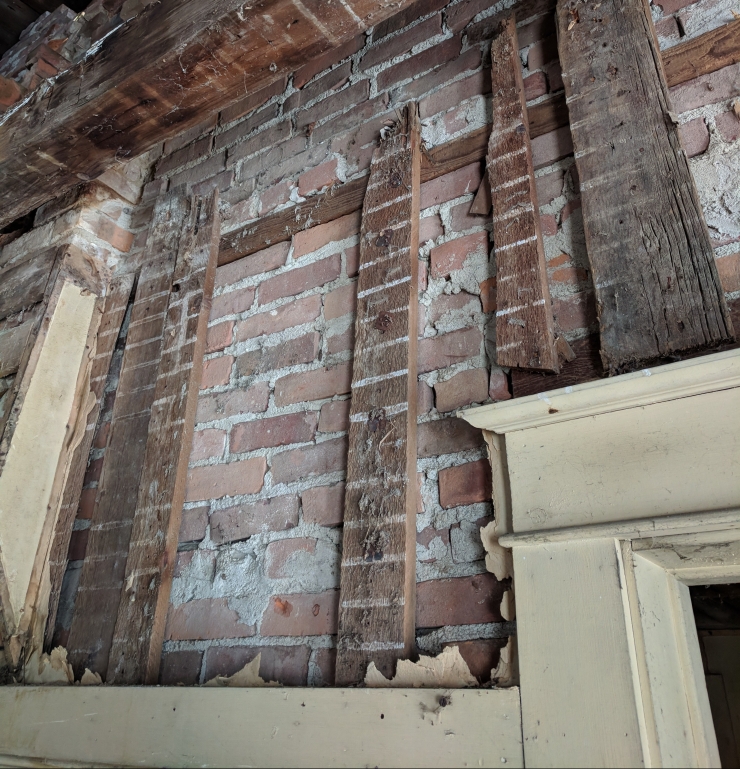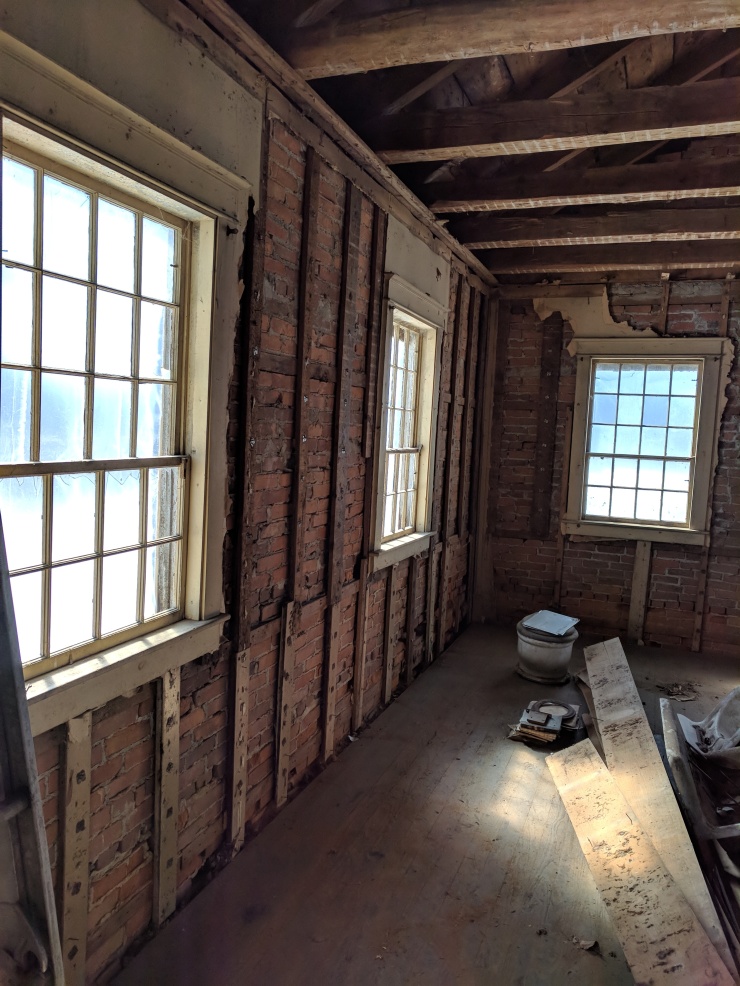A couple of weeks ago we had a representative out from the State Office of Historic Preservation. We learned so much about how our school house was built. This has put us forward leaps and bounds as we (almost) close the door on demo and focus on how to put it all back together. We learned we are eligible to be on the State and National Register of Historic Places. Governor Cuomo just announced this year’s nominations. We’re hopeful that we will be included next year!
Back to School for Me
The school house is giving me an education in so many ways. I’m learning a lot of new terms and present day and historic construction methods. Well, at least I’m trying to. I think I’m starting to annoy Gramp since for the 20th time I asked what facia was and he said “I think I’m going to get you a book.” He’s also started answering my questions by saying “google it,” which I find hilarious.
 Gramp and I love our new logo designed by my husband, Ben
Gramp and I love our new logo designed by my husband, Ben
The 1910’s is My New Favorite Decade
We learned that most of the historical features (like the doors and trim) are from a renovation that dates to the early 1900’s. As we go along with our restoration we can refer to this period and make informed choices about interior finishes. We learned so much that I’m going to spread it over two posts. Here we go!
 Bricks
Bricks
All the bricks are handmade. We found a couple of bricks with the imprint “MBCO” and our new friend in the historic office sent us some information that they are from the Montowese Brick Company in New Haven CT. He also pointed out some earlier brick repairs that were done poorly, you can see here where the mortar is missing. We are learning how to repair bricks correctly. Without getting too technical it has something to do with the right amount of limestone. If you want to go down the rabbit hole of brick making companies you can check out this website.
 we found several bricks with this imprint
we found several bricks with this imprint
Plaster and Lath
The original interior walls were plaster and lath. We had no idea! Gramp was trying to figure out why there are vertical boards with square cut nails in front of the bricks (the square cut nails indicate the boards were part of the original construction). It was how they attached the lath. You can see the lines on the walls. Even the ceiling was plaster and lath. Check out the photos of the marks on the beams. This solved a big mystery for us. We were also able to figure out that the original interior included wainscoting. Now that I know this I want to include wainscoting in the final design. You can see below a photo of a school house with the wainscoting.
 vertical boards where lath was attached
vertical boards where lath was attached
 horizontal white lines on the beams proving the original ceiling was plaster and lath
horizontal white lines on the beams proving the original ceiling was plaster and lath one room school with wainscoting, we’re hoping to add this back it to our school
one room school with wainscoting, we’re hoping to add this back it to our school
Beams
Our expert was surprised that we had hand hewn beams because by 1850 there were already saw mills in the area. He also notices the beams are center notched to tie into the roof rafters which wasn’t a common construction technique at that time. This required extra work but is a nice detail. center notched beams
center notched beams
Windows
The windows actually date to around 1810, which makes them much older than the building (1850). They must have been reused from an older structure. We were going back and forth about keeping the windows because they are quite broken and wouldn’t be energy efficient. After hearing how old they are we of course have to keep them and get them reglazed! When I asked what reglazing was Gramp explained it in a lot of detail and probably saw my eyes start to glaze. Then he told me to watch a youtube video! Doesn’t reglaze sound like pouring something over the glass?? Hint: that’s not what it is.
 our pretty 1810 windows, there are nine windows and they each have 12 over eight panes
our pretty 1810 windows, there are nine windows and they each have 12 over eight panes
Work Site Update
We had a work day on Saturday and I’m excited to report that we are almost done with interior demo. I don’t think Gramp and I realized quite how much work was left. The main room is all set. We’re not taking down any of the trim around the windows or the chalkboards for now. We just have to remove the partition walls in the addition and we’re done!
 Gramp: “We need another dumpster” Me: “No! It’s not in the budget!”
Gramp: “We need another dumpster” Me: “No! It’s not in the budget!”
So Many Shades of White
Gramp’s in charge of the order we are accomplishing our tasks and he said this spring we can paint the soffits, fascia, windows lintels and sills (look at me I know what that means now!). Em and I get to start picking colors! In the photo below you can see what paint is left. We’re considering getting close to that color. What do you think?
 left to right: Windswept Beach, Delicate White, Colonial White, we see the difference!
left to right: Windswept Beach, Delicate White, Colonial White, we see the difference!
Susie B. is Still Speaking to Me (and now Em too!)
Since the last blog I reached out to Debi Craig the President of the Washington County Historical Society and learned so much more. There’s a whole list of sites in the area that relate to Susan B. Anthony including schools she attended and taught at and a cemetery where her sister and grandparents are buried. We’re going to do a little more research and traveling and do another post on Susan B. Anthony later this spring. For now here’s my favorite photo from the trip we took to her house.
 side window of the barn/carriage house as Susan B. house, it doesn’t get more rustic than this!
side window of the barn/carriage house as Susan B. house, it doesn’t get more rustic than this!
**Thanks everyone who is following the new facebook page. I’ll post quick updates, lots of photos and links to the blog there. If you haven’t already followed it here’s the link to Gramp’s Old School.

Love what you are trying to accomplish! Our house is an old home, once the hired helps house for our farm. The cows are gone but I love my house. From research, built around 1830-40. You’re doing a great job and service to this old school.
LikeLike
Thanks so much! It’s going to be a long process but we’re excited!
LikeLike
Love your updates Jill! They are cute and fun to read. P.S. I like the colonial white! Let me know when you will be doing your Spring cleaning!
LikeLike
Aaww! I like the Colonial White too, there was another color called Cow’s Milk that is similar that I also like party because of the name!
LikeLike
What was it you found in the floor?
LikeLike
an OLD septic system! I was hoping for money!
LikeLike
Hello! I enjoyed reading about your project in the Gazette today, so I thought I’d check out your site. Very interesting, and great pictures.
By the way, I think the correct spelling is fascia, not facia. And my vote is for the Colonial White, unless of course the word ‘cow’ is in the color name 😉.
LikeLike
Haha thanks for the correction! Just goes to show I’m still learning! There’s is one color paint called Cow’s Milk that is very similar to Colonial White!
LikeLike